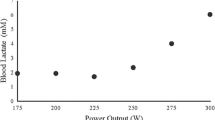Summary
Muscle metabolites and blood lactate concentration were studied in five male subjects during five constant-load cycling exercises. The power outputs were below, equal to and above aerobic (AerT) and anaerobic (AnT) threshold as determined during an incremental leg cycling test. At AerT, muscle lactate had increased significantly (p<0.05) from the rest value of 2.31 to 5.56 mmol · kg−1 wet wt. This was accompanied by a significant reduction in CP by 28% (p<0.05), whereas only a minor change (9%) was observed for ATP. At AnT muscle lactate had further increased and CP decreased although not significantly as compared with values at AerT. At the highest power outputs (> AnT) muscle lactate had increased (p<0.01) and CP decreased (p<0.01) significantly from the values observed at AnT. Furthermore, a significant reduction (p<0.05) in ATP over resting values was recorded. Blood lactate decreased significantly (p<0.01) during the last half of the lowest 5 min exercise, remained unchanged at AerT and increased significantly (p<0.05–0.01) at power outputs ⩾AnT. It is concluded that anaerobic muscle metabolism is increased above resting values at AerT: at low power outputs (⩽AerT) this could be related to the transient oxygen deficit during the onset of exercise or the increase in power output. At high power outputs (> AnT) anaerobic energy production is accelerated and it is suggested that AnT represents the upper limit of power output where lactate production and removal may attain equilibrium during constant load exercise.
Similar content being viewed by others
References
Aunola S, Rusko H (1982) The anaerobic threshold measured by four different bicycle exercise tests. Scand J Sports Sci 4:49–56
Aunola S, Rusko H (1984) Reproducibility of aerobic and anaerobic thresholds in 20–50 year old men. Eur J Appl Physiol 53:260–266
Bergström J (1962) Local changes of ATP and phosphorylcreatine in human muscle tissue in connection with exercise. In: Chapman CB (ed) Physiology of muscular exercise. The American heart association, Monograph 15:91–86
Chasiotis D, Sahlin K, Hultman E (1982) Regulation of glycogenolysis in human muscle at rest and during exercise. J Appl Physiol: Respirat Environ Exercise Physiol 53:708–715
Di Prampero PE (1981) Energetics of muscular exercise. Rev Physiol Biochem Pharmacol 89:143–222
Donovan CM, Brooks GA (1983) Endurance training affects lactate clearance, not lactate production. Am J Physiol 244:E83-E92
Green HJ, Hughson RL, Orr GW, Ranney DA (1983) Anaerobic threshold, blood lactate, and muscle metabolites in progressive exercise. J Appl Physiol: Respirat Environ Exercise Physiol 54:1032–1038
Harris RC, Edwards RHT, Hultman E, Nordesjö L-O, Nylund B, Sahlin K (1976) The time course of phosphorylcreatine resynthesis during recovery of the quadriceps muscle in man. Pflügers Arch 367:137–142
Harris RC, Sahlin K, Hultman E (1977) Phosphagen and lactate contents of m. quadriceps femoris of man after exercise. J Appl Physiol: Respirat Environ Exercise Physiol 43:852–857
Hermansen L, Stensvold I (1972) Production and removal of lactate during exercise in man. Acta Physiol Scand 86:191–201
Ivy JL, Withers RT, Van Handel PJ, Elger DH, Costill DL (1980) Muscle respiratory capacity and fiber type as determinants of the lactate threshold. J Appl Physiol: Respirat Environ Exercise Physiol 48:523–527
Jacobs I, Kaiser P (1982) Lactate in blood, mixed skeletal muscle, and FT or ST fibres during cycle exercise in man. Acta Physiol Scand 114:461–466
Jorfeldt L, Juhlin-Dannfeldt A, Karlsson J (1978) Lactate release in relation to tissue lactate in human skeletal muscle during exercise. J Appl Physiol: Respirat Environ Exercise Physiol 44:350–352
Karlsson J (1971) Lactate and phosphagen concentrations in working muscle of man with special reference to oxygen deficit at the onset of work. Acta Physiol Scand [Suppl 358]
Karlsson J, Nordesjö L-O, Jorfeldt L, Saltin B (1972) Muscle lactate, ATP, and CP levels during exercise after physical training in man. J Appl Physiol 33:199–203
Kindermann W, Simon G, Keul J 1979) The significance of the aerobic-anaerobic transition for the determination of work load intensities during endurance training. Eur J Appl Physiol 42:25–34
Lowry OH, Passonneau JV (1972) A flexible system of enzymatic analysis. Academic Press, New York
Mader A, Liesen H, Heck H, Philippi H, Rost R, Schüren P, Hollmann W (1976) Zur Beurteilung der sportartspezifischen AusdauerleistungsfÄhigkeit im Labor. Sportarzt Sportmed 27:80–88
Newsholme EA (1977) The regulation of extracellular and intracellular fuel supply during sustained exercise. Ann NY Acad Sci 301:81–91
NÄveri H, Rehunen S, Kuoppasalmi K, Tulikoura I, HÄrkönen M (1978) Muscle metabolism during and after strenuous intermittent running. Scand J Clin Lab Invest 38:329–336
Piiper J, Spiller P (1970) Repayment of O2 debt and resynthesis of high-energy phosphates in gastrocnemius muscle of the dog. J Appl Physiol 28:657–662
Piiper J, Di Prampero PE, Cerretelli P (1968) Oxygen debt and high energy phosphates in gastrocnemius muscle of the dog. Am J Physiol 215:523–531
Rusko H, Rahkila P, Karvinen E (1980) Anaerobic threshold skeletal muscle enzymes and fiber composition in young female cross-country skiers. Acta Physiol Scand 108:263–268
Sahlin K (1978) Intracellular pH and energy metabolism in skeletal muscle of man. Acta Physiol Scand [Suppl] 455:1–56
Schnabel A, Kindermann W, Schmitt WM, Biro G, Stegman H (1982) Hormonal and metabolic consequences of prolonged running at the individual anaerobic threshold. Int J Sports Med 3:163–168
Sjödin B, Jacobs I, Karlsson J (1981) Onset of blood lactate accumulation and enzyme activities in m. vastus lateralis in man. Int J Sports Med 2:166–170
Skinner JS, McLellan TH (1980) The transition from aerobic to anaerobic metabolism. Res Q Exerc Sport 51:234–248
Stegmann H, Kindermann W (1982) Comparison of prolonged exercise tests at the individual anaerobic threshold and the fixed anaerobic threshold of 4 mmol · l−1 lactate. Int J Sports Med 3:105–110
Stegmann H, Kindermann W, Schnabel A (1981) Lactate kinetics and individual anaerobic threshold. Int J Sports Med 2:160–165
Tesch PA, Daniels WL, Sharp DS (1982) Lactate accumulation in muscle and blood during submaximal exercise. Acta Physiol Scand 114:441–446
Wassermann K, Whipp BJ, Koyal SN, Beaver WL (1973) Anaerobic threshold and respiratory gas exchange during exercise. J Appl Physiol 35:236–243
Author information
Authors and Affiliations
Rights and permissions
About this article
Cite this article
Rusko, H., Luhtanen, P., Rahkila, P. et al. Muscle metabolism, blood lactate and oxygen uptake in steady state exercise at aerobic and anaerobic thresholds. Europ. J. Appl. Physiol. 55, 181–186 (1986). https://doi.org/10.1007/BF00715002
Accepted:
Issue Date:
DOI: https://doi.org/10.1007/BF00715002




